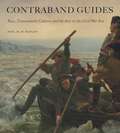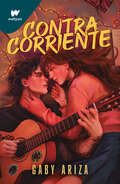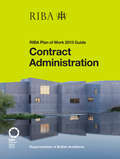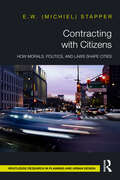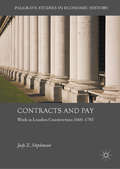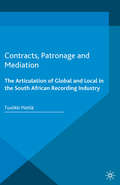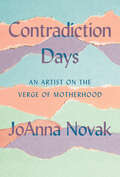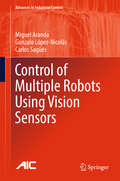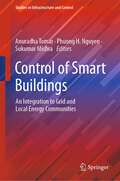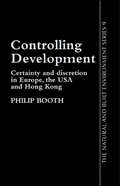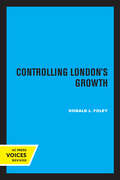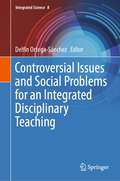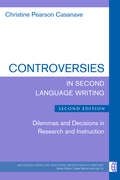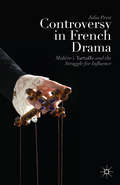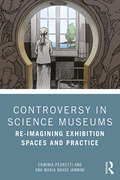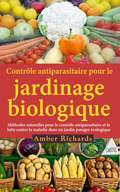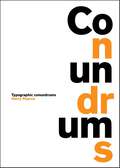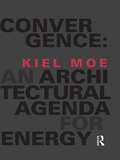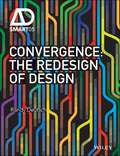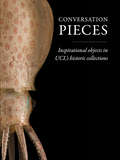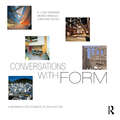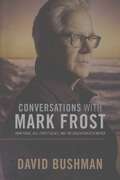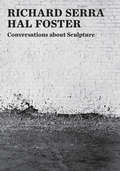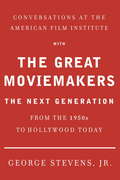- Table View
- List View
Contraband Guides: Race, Transatlantic Culture, and the Arts in the Civil War Era
by Paul H. KaplanIn his best-selling travel memoir, The Innocents Abroad, Mark Twain punningly refers to the black man who introduces him to Venetian Renaissance painting as a “contraband guide,” a term coined to describe fugitive slaves who assisted Union armies during the Civil War. By means of this and similar case studies, Paul H. D. Kaplan documents the ways in which American cultural encounters with Europe and its venerable artistic traditions influenced nineteenth-century concepts of race in the United States.Americans of the Civil War era were struck by the presence of people of color in European art and society, and American artists and authors, both black and white, adapted and transformed European visual material to respond to the particular struggles over the identity of African Americans. Taking up the work of both well- and lesser-known artists and writers—such as the travel writings of Mark Twain and William Dean Howells, the paintings of German American Emanuel Leutze, the epistolary exchange between John Ruskin and Charles Eliot Norton, newspaper essays written by Frederick Douglass and William J. Wilson, and the sculpture of freed slave Eugène Warburg—Kaplan lays bare how racial attitudes expressed in mid-nineteenth-century American art were deeply inflected by European traditions.By highlighting the contributions people of black African descent made to the fine arts in the United States during this period, along with the ways in which they were represented, Contraband Guides provides a fresh perspective on the theme of race in Civil War–era American art. It will appeal to art historians, to specialists in African American studies and American studies, and to general readers interested in American art and African American history.
Contraband Guides: Race, Transatlantic Culture, and the Arts in the Civil War Era (G - Reference, Information And Interdisciplinary Subjects Ser.)
by Paul H. KaplanIn his best-selling travel memoir, The Innocents Abroad, Mark Twain punningly refers to the black man who introduces him to Venetian Renaissance painting as a "contraband guide," a term coined to describe fugitive slaves who assisted Union armies during the Civil War. By means of this and similar case studies, Paul H. D. Kaplan documents the ways in which American cultural encounters with Europe and its venerable artistic traditions influenced nineteenth-century concepts of race in the United States.Americans of the Civil War era were struck by the presence of people of color in European art and society, and American artists and authors, both black and white, adapted and transformed European visual material to respond to the particular struggles over the identity of African Americans. Taking up the work of both well- and lesser-known artists and writers—such as the travel writings of Mark Twain and William Dean Howells, the paintings of German American Emanuel Leutze, the epistolary exchange between John Ruskin and Charles Eliot Norton, newspaper essays written by Frederick Douglass and William J. Wilson, and the sculpture of freed slave Eugène Warburg—Kaplan lays bare how racial attitudes expressed in mid-nineteenth-century American art were deeply inflected by European traditions.By highlighting the contributions people of black African descent made to the fine arts in the United States during this period, along with the ways in which they were represented, Contraband Guides provides a fresh perspective on the theme of race in Civil War–era American art. It will appeal to art historians, to specialists in African American studies and American studies, and to general readers interested in American art and African American history.
Contracorriente
by Gaby ArizaUn amor único e inolvidable, una cuenta regresiva y un destino que desafía todas las probabilidades. Maju debe dejar atrás todo lo que conoce y viajar a otro país para terminar sus estudios. Al llegar a su nuevo hogar se encuentra con una ciudad llena de vida, amigos nuevos y... el enigmático cantante y guitarrista de la banda Indie Gentes, que además es su compañero de curso. Santi es distante y reservado. No parece encajar en ningún lado. La música es su único refugio. Pero la conexión con Maju es instantánea y entre ellos nace un amor apasionado que empieza a desarmar los muros que lo protegían. Solo hay un problema: Maju tiene planeado continuar su viaje cuando termine el colegio y Santi va a quedarse en su ciudad para intentar triunfar con la música. ¿Serán capaces de amar a contracorriente? Los lectores dicen:«Esta historia es ese lugar feliz al que me gusta volver una y otra vez. Santi y Maju tienen un lugar muy especial en mi corazón». «La amé, sentí todos y cada uno de los momentos como si fuesen míos». «Maravillosamente real».«Este libro me hizo sentir que pertenezco a algún lugar». «Es uno de los libros más lindos que he leído, lo amo».
Contract Administration: RIBA Plan of Work 2013 Guide
by Ian DaviesThe RIBA Plan of Work 2013 Guide: Design Management is part of a brand new series providing must-read practical guidance to running efficient and successful projects using the new RIBA Plan of Work 2013. Each guide takes a core project task – in this case the role of the Contract Administrator - and explains the essential activities and considerations required at each stage of the new Plan of Work. Easy to use and navigate and in a small and handy format these guides will provide the ultimate quick reference support at your desk or on site. The author provides concise and pragmatic advice rooted in real world experience – a ‘how to’ that will resonate with practitioners. In-text features such as ‘hints and tips’, ‘checklists’, ‘forms and templates’ and ‘signposts’ to trusted resources will provide user-friendly support. Boxed examples will highlight best practice and illuminate common problems and solutions borne of hard won experience.
Contracting with Citizens: How Morals, Politics, and Laws Shape Cities (Routledge Research in Planning and Urban Design)
by E.W. (Michiel) StapperThis book demonstrates that contracts, community intermediaries, and participatory processes are closely interlinked, and they can change urban politics.In participatory processes, residents negotiate with policymakers about the future of their neighborhood. In the last few decades, this happened increasingly in co-creation sessions where citizens are deemed to have an equal position vis-a-vis developers and civil servants. The goal of this book is to understand and theorize how these negotiations affect collective action. The book will scrutinize the role of contracts, community intermediaries, and participatory processes in development projects and planning policies. Using a comparative case study of Amsterdam, Hamburg, and New York, this book reveals how seemingly fresh and novel planning practices are used to justify processes of capital accumulation and reveals how morals, politics, and law can create institutional change.The book presents a novel theoretical approach to studying urban politics, putting emphasis on (private) law and the material arrangements of participatory processes. It will be of interest to researchers and students of planning, geography, sociology, public administration, and law and will provide valuable lessons for practitioners interested in understanding the effects of contractual governance on neighborhoods.
Contracts and Pay: Work in London Construction 1660–1785 (Palgrave Studies in Economic History)
by Judy Z. StephensonThis book presents a new economic history of London construction in the early modern period. Drawing on extensive archival material from key sites such as St Paul’s Cathedral and London Bridge, it describes the organization of contracts and work on large-scale ‘extraordinary’ projects and maintenance contracts in the city during a key period of architectural and organizational development in Britain. Stephenson shows that the organisation of the industry and the welfare of its workers were shaped by the contracts and finance of large institutions and ambitious businessmen. Providing fresh wage and earnings data for craftsmen and labourers during the period, it offers new material and debate for economic, business and construction historians.
Contracts, Patronage and Mediation: The Articulation of Global and Local in the South African Recording Industry (Pop Music, Culture and Identity)
by Tuulikki PietiläThis book studies the long-term developments in the South African recording industry and adds to the existing literature an understanding of the prevalence of informal negotiations over rights, rewards and power in the recording industry. It argues that patronage features often infiltrate the contractual relationships in the industry.
Contradiction Days: An Artist on the Verge of Motherhood
by JoAnna NovakFor readers of Rachel Cusk and Maggie Nelson, the rapturous memoir of a soon-to-be-mother whose obsession with the reclusive painter Agnes Martin threatens to upend her lifeFive months pregnant and struggling with a creative block, JoAnna Novak becomes obsessed with the enigmatic abstract expressionist painter Agnes Martin. She is drawn to the contradictions in Martin&’s life as well as her art—the soft and exacting brushstrokes she employs for grid-like compositions that are both rigid and dreamy. But what most calls to JoAnna is Martin&’s dedication to her work in the face of paranoid schizophrenia.Uneasy with the changes her pregnant body is undergoing, JoAnna relapses into damaging old habits and thought patterns. When she confides in her doctor that she&’s struggling with depression and suicidal ideation, he tells her she must stop being so selfish, given she has a baby on the way, and start taking antidepressants. Appalled by his patronizing tone and disregard of her mental health history, JoAnna instead turns to Martin for guidance, adopting the artist's doctrine of joyful solitude and isolation.JoAnna heads to Taos, where Martin lived for decades, and gives herself three weeks to model her hermetic existence: phone off, email off, no talking to her husband, no touching the dog. Out of a deep, solitary engagement with a remarkable artist&’s body of work emerges an entirely new way for JoAnna to relate to the contradictions of her own body and face up to the joys and challenges of impending motherhood.
Control of Multiple Robots Using Vision Sensors (Advances in Industrial Control)
by Carlos Sagüés Miguel Aranda Gonzalo López-NicolásThis monograph introduces novel methods for the control and navigation of mobile robots using multiple-1-d-view models obtained from omni-directional cameras. This approach overcomes field-of-view and robustness limitations, simultaneously enhancing accuracy and simplifying application on real platforms. The authors also address coordinated motion tasks for multiple robots, exploring different system architectures, particularly the use of multiple aerial cameras in driving robot formations on the ground. Again, this has benefits of simplicity, scalability and flexibility. Coverage includes details of: a method for visual robot homing based on a memory of omni-directional images; a novel vision-based pose stabilization methodology for non-holonomic ground robots based on sinusoidal-varying control inputs; an algorithm to recover a generic motion between two 1-d views and which does not require a third view; a novel multi-robot setup where multiple camera-carrying unmanned aerial vehicles are used to observe and control a formation of ground mobile robots; and three coordinate-free methods for decentralized mobile robot formation stabilization. The performance of the different methods is evaluated both in simulation and experimentally with real robotic platforms and vision sensors. Control of Multiple Robots Using Vision Sensors will serve both academic researchers studying visual control of single and multiple robots and robotics engineers seeking to design control systems based on visual sensors.
Control of Smart Buildings: An Integration to Grid and Local Energy Communities (Studies in Infrastructure and Control)
by Sukumar Mishra Anuradha Tomar Phuong H. NguyenThis book provides an overview of how efficient building energy management can be done, considering the increasing importance of renewable energy integration. It also includes the grid-interactive building, their control, energy management, and optimization techniques to promote better understanding among researchers and business professionals in the utility sector and across industries. This book is written and edited by leading specialists active in concurrent developments in smart building management, renewable energy research, and application-driven R&D. The experiences and research work shared help the readers in enhancing their knowledge in the field of renewable energy, power engineering, building energy management, demand, and supply management and learn the technical analysis of the same in an insightful manner. Additionally, established and emerging applications related to applied areas like smart cities, the Internet of things, machine learning, artificial intelligence, etc., are developed and utilized to demonstrate recent innovations in smart building energy management.
Controlling Development: Certainty, Discretion And Accountability (Planning, History And Environment Ser.)
by Booth, PhilipFirst published in 1996. Routledge is an imprint of Taylor & Francis, an informa company.
Controlling London's Growth: Planning the Great Wen, 1940 - 1960
by Donald L. FoleyThe story recounted here--that of efforts in recent years to plan for Greater London--is both unique and important. It concerns a world metropolis that, faced with an urgent need to rebuild its war-damaged central areas while still at war, prepared a notable set of special plans. And it describes subsequent vigorous efforts to carry these plans into effect. The London record is singularly impressive, unmatched by metropolitan planning efforts elsewhere. It has implications for metropolitan areas in other countries that are seeking solutions to comparable problems--problems reflecting unanticipated growth, technological and functional change, governmental chaos, and the reformulation of social requirements. Foley presents the first comprehensive factual analysis--British or otherwise--of the London planning experience. He offeres and original, sophisticated discussion of the social doctrine incorporated in the plans, and explains its emphasis on the principle of "containing" metropolitan London. He examines the context within which this doctrine emerged, investigates the suitability of this doctrine in the light of subsequent developments, and discusses possibilities for a fresh look at the main planning policies for Greater London. His approach gives the book depth without turning it into a specialized academic treatise. It speaks directly to thoughtful city-dwellers who are concerned to control rather than to be controlled by their environment. This title is part of UC Press's Voices Revived program, which commemorates University of California Press's mission to seek out and cultivate the brightest minds and give them voice, reach, and impact. Drawing on a backlist dating to 1893, Voices Revived makes high-quality, peer-reviewed scholarship accessible once again using print-on-demand technology. This title was originally published in 1963.
Controversial Issues and Social Problems for an Integrated Disciplinary Teaching (Integrated Science #8)
by Delfín Ortega-SánchezThe scientific literature has been showing that the teaching of controversial topics constitutes one of the most powerful tools for the promotion of active citizenship, the development and acquisition of critical-reflective thinking skills (Misco, 2013), and education for democratic citizenship (Pollak, Segal, Lefstein, and Meshulam, 2017; Misco and Lee, 2014). It has also highlighted, however, the complexities, risks and interference of emotional reactions in learning about sensitive, controversial or controversial historical, geographical or social issues (Jerome and Elwick, 2019; Reiss, 2019; Ho and Seow, 2015; Washington and Humphries, 2011; Swalwell and Schweber, 2016).Recent studies have advanced in the analysis of strategies employed by teacher educators in teaching controversial issues (Nganga, Roberts, Kambutu, and James, 2019; Pace, 2019), and in the curricular decisions of teachers about this teaching (Hung, 2019; King, 2009). These developments confirm the appropriateness of discussing or developing deliberative skills and conversational learning as the most appropriate strategy for the didactic treatment of controversial issues (Claire and Holden, 2007; Hand, 2008; Hess, 2002; Oulton, Day, Dillon and Grace, 2004; Oulton, Dillon and Grace, 2004; Myhill, 2007; Hand and Levinson, 2012; Ezzedeen, 2008). The promotion of discussion on specific social justice issues has also been approached from the use of controversial or documentary images in teacher education contexts, in order to question what is happening or has happened in present and past societies (Hawley, Crowe, and Mooney, 2016; Marcus and Stoddard, 2009).In this context, the aim of this contributed volume is, on one hand, to understand the discourses and decision-making of teachers on controversial issues in interdisciplinary educational contexts and their association with the development of deliberation skills. On the other hand, it seeks to offer studies focused on the analysis of the levels of coherence between their attitudes, positions and teaching practices for the teaching and learning of social problems and controversial issues from an integrated disciplinary perspective.
Controversies in Second Language Writing, Second Edition: Dilemmas and Decisions in Research and Instruction
by Christine Pearson CasanaveIn the years since the first edition of Controversies in Second Language Writing was published, there been little to no clear resolution of the controversies Casanave so accessibly and fair-mindedly laid out. In fact, many of them have become far more complex and intertwined with many other 21st century issues that teachers of L2 writing cannot help but be affected by in their classrooms. Therefore, this second edition has set out to address: What issues if any have been resolved? What issues have had lasting power from the past, either because people are resistant to change or because the issues continue to be unresolved ones that writing teachers and scholars need to keep discussing? The second edition is a thorough revision with all chapters updated to refer to works written since the first edition was published. A few chapters have been added: one devoted to writing in a digital era (Chapter 3); one devoted to the debates about English as a lingua franca, "translingual literacy practices," and other hybrid uses of English that have been ongoing in the last ten years (Chapter 4); and one giving special attention to issues related to writing from sources and plagiarism (Chapter 6). As with the first edition, the second edition of Controversies is not a book that will teach readers how to do things. Rather, it is a book designed to help readers think and to wrestle with issues in L2 writing that are not easily resolved by how-to prescriptions.
Controversy in French Drama: Molière’s Tartuffe and the Struggle for Influence
by Julia PrestIn 1664, Molière's Tartuffe was banned from public performance. This book provides a detailed, in-depth account of five-year struggle (1664-69) to have the ban lifted and, so doing, sheds important new light on 1660s France and the ancien régime more broadly.
Controversy in Science Museums: Re-imagining Exhibition Spaces and Practice
by Erminia Pedretti Ana Maria Navas IanniniControversy in Science Museums focuses on exhibitions that approach sensitive or controversial topics. With a keen sense of past and current practices, Pedretti and Navas Iannini examine and re-imagine how museums and science centres can create exhibitions that embrace criticality and visitor agency. Drawing on international case studies and voices from visitors and museum professionals, as well as theoretical insights about scientific literacy and science communication, the authors explore the textured notion of controversy and the challenges and opportunities practitioners may encounter as they plan for and develop controversial science exhibitions. They assert that science museums can no longer serve as mere repositories for objects or sites for transmitting facts, but that they should also become spaces for conversations that are inclusive, critical, and socially responsible. Controversy in Science Museums provides an invaluable resource for museum professionals who are interested in creating and hosting controversial exhibitions, and for scholars and students working in the fields of museum studies, science communication, and social studies of science. Anyone wishing to engage in an examination and critique of the changing roles of science museums will find this book relevant, timely, and thought provoking.
Contrôle antiparasitaire pour le jardinage biologique
by Amber Richards Véronique MazetÊtes-vous inquiet lorsque vous répandez des produits chimiques toxiques dans votre jardin, spécialement si vous faites pousser des légumes, des herbes aromatiques et des fruits? Ce serait légitime, puisque ces produits peuvent présenter des risques pour votre famille, vos animaux domestiques et pour l'environnement. Mais le problème est bien réel. Comment protéger votre jardin des différents parasites et des maladies qui peuvent le détruire? "Contrôle antiparasitaire pour le jardinage biologique" est un ebook pour les jardiniers (spécialement pour les jardiniers débutants), qui propose des méthodes pratiques et parfois étonnantes pour traiter ce problème de façon biologique et naturelle. La nourriture biologique que vous faites pousser sera plus saine, aura un meilleur goût, et sera plus fraîche que les produits équivalents traités chimiquement. C'est aussi une manière de promouvoir un environnement plus sain pour tout le monde. Cultiver votre propre potager biologique fera non seulement baisser vos frais d'alimentation, ce sera aussi un passe-temps agréable. Même si vous n'avez pas la place ou le temps pour un véritable potager, un petit parterre ou des pots sont de bonnes solutions. Dans tous les cas, avec ces informations vous obtiendrez de meilleurs résultats, et une récolte de qualité. Téléchargez votre ebook maintenant.
Conundrums: Typographic Conundrums
by Harry PearceConundrum is a mind-stretch. Encrypting idioms into their typographic equivalents, Harry enlivens our everyday language and challenges readers to see that "time after time after time" or, at least, "more often than not" "the writing is on the wall." For fans of word puzzles, sudoku, crosswords, and all manner of mind games, Conundrum offers an artfully packaged, cleverly designed new challenge. Drawing upon, literally in this case, graphic puzzles that he began creating as a child, Harry's developed over 100 witty conundrums for this book that will stretch the mind as well as delight the senses. A member of the Alliance Graphique Internationale, a frequent lecturer and contributor to design discourse, an internationally recognized leader in design, and a founder of Lippa Pearce, one of the UK's most respected design agencies, Harry refines the way we see and communicate. Conundrum achieves nothing less than changing how we understand and interact with language.
Convergence: An Architectural Agenda For Energy
by Kiel MoeConvergence is based on the thermodynamic premise that architecture should maximize its ecological and architectural power. No matter how paradoxical it might initially seem, architects should maximize energy intake, maximize energy use, and maximize energy feedback and reinforcement. This presumes that the necessary excess of architecture is in fact an architect’s greatest asset when it comes to an agenda for energy, not a liability. But how do we start to understand the full range of eco-thermodynamic principles which need to be engaged with in order to achieve this? Kiel Moe explicates three factors: materials, energy systems and amortization. When these three factors converge through design, the resulting buildings begin to perform in complex, if not subtle, ways. By drawing on a range of architectural, thermodynamic, and ecological sources as well as illustrated and well-designed case studies, the author shows what architecture stands to gain by simultaneously maximizing the architectural and ecological power of buildings. .
Convergence: The Redesign of Design (AD Smart)
by Randy Deutsch"There is today a pronounced and accelerated convergence in architecture. This convergence is occurring by doers not thinkers; in practice not academia; in building design, fabrication, and construction. It is about solution-centric individuals engaged in real time problem solving, not in abstractions. The nature of this convergence, where things are converging and what that means for architecture, is the subject of this book."—from the IntroductionThose working in architecture and engineering feel pressure to work faster, at lower cost, while maintaining a high level of innovation and quality. At the same time, emergent tools and processes make this possible. Convergence is about the firms, teams and people who thrive in this environment as a result of their ability to creatively combine and innovate. It seeks to answer several timely questions: What are the tools and work processes that are converging? How are individuals and organizations converging their tools and work processes? What challenges and benefits are they seeing? What is the ultimate endgame of this convergence? What skillsets and mindsets would someone need to develop to work effectively in this changing environment? What are the implications of convergence on the role of the designer, and on design? On how we design, build, fabricate, and construct? On how we work? The book explains how convergence relates to, but ultimately differs from integration, consolidation, multi-tasking, automation, and other forms of optimization. The practice-based research builds upon the author’s research in BIM and in the collaborative leveraging of data in design and fabrication. As an investigation and meditation on the impact of technology on the education and making of design professionals Convergence explains what is happening in the world of design, and discusses the implications for the future of education, training and practice.
Conversation Pieces
by Mark CarnallThis book, beautifully illustrated with specially commissioned photography, is a celebration of UCL's unique collections, with leading academics from the university invited to select and write about an object each found inspiring. From a jar of moles to an Egyptian unguent spoon, a finger X-ray to some prehistoric cereal grains, their choices were often surprising, their responses always fascinating.
Conversations With Form: A Workbook for Students of Architecture
by N. John Habraken Andrés Mignucci Jonathan TeicherThrough a progressive series of exercises - accompanied by observational studies, examples and applied theory - Conversations with Form: A Workbook for Students of Architecture improves designers’ understanding, dexterity and resilience in making form. It specifically focuses on the skills needed to succeed in the everyday context in which the vast majority of architects will ultimately design and build, wherein no one designs in isolation and existing conditions never represent a tabula rasa. The text begins by familiarizing readers with utilizing step-by-step sequences of moves to steer the development of built form and rapidly moves to designs of increasing complexity. These design plays treat a wide-ranging series of topics including structures, patterns, types, systems and other kinds of shared form principles. Conversations with Form is a workbook for honing hands-on skills and tools of the architect’s trade. Beautifully illustrated and focused on practical, usable information, the book provides architectural students with an accessible and useable handbook for their design practice.
Conversations With Mark Frost: Twin Peaks, Hill Street Blues, and the Education of a Writer
by David BushmanTwin Peaks co-creator Mark Frost dishes about his long and storied career, including his time as a stagehand at Mister Rogers' Neighborhood ; his early days as a a young bachelor in Hollywood rooming with Adam Arkin and Michael O'Keefe; his brief time at Universal TV before chucking it all away to return home to Minnesota to work on documentaries; his experiences in the infamous Hill Street Blues writing room with Steven Bochco and David Milch; and, finally, his career-defining collaboration with David Lynch on Twin Peaks.Mark Frost, cocreator of both the original Twin Peaks and The Return, is often lost in the shadow of co-creator David Lynch in the eyes of critics and scholars -- one newspaper even called him the "Other Peak." In fact, Frost played at least as crucial a role in developing the narrative, mythology, and aesthetic of what has come to be revered as one of the most artful and influential shows ever to air on television. This book, comprising a series of interviews with Frost over the course of a single year, finally and fully acknowledges the extent of Frost's contributions not only to those series, but also to American television in general, as a writer/producer on Hill Street Blues and other shows, and as a mentor to numerous other writers. The book traces the arc of his entire life and career, from his boyhood days in New York, Los Angeles, and Minneapolis, to his nascent playwriting career in Pittsburgh, to his days as a writer at Universal TV's famed factory of the seventies, to his work on Hill Street Blues alongside such industry titans as Steven Bochco and David Milch, to his multiple collaborations with the famously enigmatic Lynch, who perhaps emerges as slightly less enigmatic in the pages of this book. Conversations with Mark Frost deconstructs that legendary partnership, while at the same time exploring Frost's values, influences, thematic preoccupations, and approach to creating art -- for the screen, the stage, and the printed page -- as well as his thoughts about such topics as politics, extraterrestrial life, ethics, and the future of the human race.
Conversations about Sculpture
by Hal Foster Richard Serra“The rhythm of the body moving through space has been the motivating source of most of my work.”—Richard Serra Drawn from talks between celebrated artist Richard Serra and acclaimed art historian Hal Foster held over a fifteen-year period, this volume offers revelations into Serra’s prolific six-decade career and the ideas that have informed his working practice. Conversations about Sculpture is both an intimate look at Serra’s life and work, with candid reflections on personal moments of discovery, and a provocative examination of sculptural form from antiquity to today. Serra and Foster explore such subjects as the artist’s work in steel mills as a young man; the impact of music, dance, and architecture on his art; the importance of materiality and site specificity to his aesthetic; the controversies and contradictions his work has faced; and his belief in sculpture as experience. They also discuss sources of inspiration—from Donatello and Brancusi to Japanese gardens and Machu Picchu—revealing a history of sculpture across time and culture through the eyes of one of the medium’s most brilliant figures. Introduced with an insightful preface by Foster, this probing dialogue is beautifully illustrated with duotone images that bring to life both Serra's work and his key commitments.
Conversations at the American Film Institute with the Great Moviemakers
by George Stevens Jr.A companion volume to George Stevens, Jr.'s, much admired book of American Film Institute seminars with the great pioneering moviemakers ("Invaluable"--Martin Scorsese).Those represented here--directors, producers, writers, actors, cameramen, composers, editors--are men and women working in pictures, beginning in 1950, when the studio system was collapsing and people could no longer depend on, or were bound by, the structure of studio life to make movies. Here also are those who began to work long after the studio days were over--Robert Altman, David Lynch, Steven Spielberg, among them--who talk about how they came to make movies on their own. Some--like Peter Bogdanovich, Nora Ephron, Sydney Pollack, François Truffaut--talk about how they were influenced by the iconic pictures of the great pioneer filmmakers. Others talk about how they set out to forge their own paths--John Sayles, Roger Corman, George Lucas, et al. In this series of conversations held at the American Film Institute, all aspects of their work are discussed. Here is Arthur Penn, who began in the early 1950s in New York with live TV, directing people like Kim Stanley and such live shows as Playhouse 90, and on Broadway, directing Two for the Seesaw and The Miracle Worker, before going on to Hollywood and directing Mickey One and Bonnie and Clyde, among other pictures, talking about working within the system. ("When we finished Bonnie and Clyde," says Penn, "the film was characterized rather elegantly by one of the leading Warner executives as a 'piece of shit' . . . It wasn't until the picture had an identity and a life of its own that the studio acknowledged it was a legitimate child of the Warner Bros. operation.") Here in conversation is Sidney Poitier, who grew up on an island without paved roads, stores, or telephones, and who was later taught English without a Caribbean accent by a Jewish waiter, talking about working as a janitor at the American Negro Theater in exchange for acting lessons and about Hollywood: It "never really had much of a conscience . . . This town never was infected by that kind of goodness." Here, too, is Meryl Streep, America's premier actress, who began her career in Julia in 1977, and thirty odd years later, at sixty, was staring in The Iron Lady, defying all the rules about "term limits" and a filmmaking climate tyrannized by the male adolescent demographic . . . Streep on making her first picture, and how Jane Fonda took her under her wing ("That little line on the floor," Fonda warned Streep, "don't look at it, that's where your toes are supposed to be. And that's how you'll be in the movie. If they're not there, you won't be in the movie"). Streep on the characters she chooses to play: "I like to defend characters that would otherwise be misconstrued or misunderstood." The Next Generation is a fascinating revelation of the art of making pictures.
